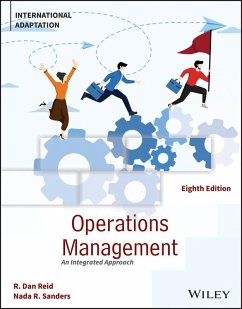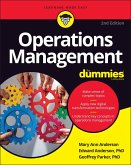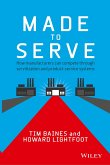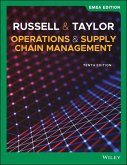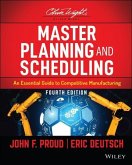R. Dan Reid (University of New Hampshire), Nada R. Sanders (Wright State University)
Operations Management
An Integrated Approach, International Adaptation
R. Dan Reid (University of New Hampshire), Nada R. Sanders (Wright State University)
Operations Management
An Integrated Approach, International Adaptation
- Broschiertes Buch
- Merkliste
- Auf die Merkliste
- Bewerten Bewerten
- Teilen
- Produkt teilen
- Produkterinnerung
- Produkterinnerung
Operations Management: An Integrated Approach, 8th edition, provides a solid foundation of the subject with clear, guided instructions and a balance between quantitative and qualitative concepts, thus providing both an applied and practical approach. In addition to leveraging customizable, tactile teaching and learning methods, the text covers emerging topics like artificial intelligence, robotics, data analytics, and sustainability. This international edition includes several revisions and additions to the content, including updated company examples across all chapters, updated discussions…mehr
Andere Kunden interessierten sich auch für
![Operations Management for Dummies Operations Management for Dummies]() Mary Ann Anderson (University of Texas, Austin, TX)Operations Management for Dummies28,99 €
Mary Ann Anderson (University of Texas, Austin, TX)Operations Management for Dummies28,99 €![Made to Serve Made to Serve]() Timothy BainesMade to Serve73,99 €
Timothy BainesMade to Serve73,99 €![Operations and Supply Chain Management, EMEA Edition Operations and Supply Chain Management, EMEA Edition]() Roberta S. Russell (Virginia Tech)Operations and Supply Chain Management, EMEA Edition78,99 €
Roberta S. Russell (Virginia Tech)Operations and Supply Chain Management, EMEA Edition78,99 €![Master Planning and Scheduling Master Planning and Scheduling]() John F. ProudMaster Planning and Scheduling144,99 €
John F. ProudMaster Planning and Scheduling144,99 €![Essential Manufacturing Essential Manufacturing]() Gordon MairEssential Manufacturing52,99 €
Gordon MairEssential Manufacturing52,99 €![Project Management Leadership Project Management Leadership]() Rory Burke (Promatec International)Project Management Leadership42,99 €
Rory Burke (Promatec International)Project Management Leadership42,99 €![Essential Guide to Operations Management Essential Guide to Operations Management]() David BamfordEssential Guide to Operations Management51,99 €
David BamfordEssential Guide to Operations Management51,99 €-
-
-
Operations Management: An Integrated Approach, 8th edition, provides a solid foundation of the subject with clear, guided instructions and a balance between quantitative and qualitative concepts, thus providing both an applied and practical approach. In addition to leveraging customizable, tactile teaching and learning methods, the text covers emerging topics like artificial intelligence, robotics, data analytics, and sustainability. This international edition includes several revisions and additions to the content, including updated company examples across all chapters, updated discussions with regard to the latest technologies that impact operations and supply chain management, and revised problems in all chapters. In addition, the edition includes a new "Pandemic Effects" box that addresses how the chapter topic has evolved or changed during the COVID-19 pandemic and how it is evolving in a post-pandemic environment.
Hinweis: Dieser Artikel kann nur an eine deutsche Lieferadresse ausgeliefert werden.
Hinweis: Dieser Artikel kann nur an eine deutsche Lieferadresse ausgeliefert werden.
Produktdetails
- Produktdetails
- Verlag: John Wiley & Sons Inc
- 8 ed
- Seitenzahl: 672
- Erscheinungstermin: 20. Juni 2024
- Englisch
- Abmessung: 276mm x 216mm x 25mm
- Gewicht: 1456g
- ISBN-13: 9781394226429
- ISBN-10: 139422642X
- Artikelnr.: 69038625
- Herstellerkennzeichnung
- Libri GmbH
- Europaallee 1
- 36244 Bad Hersfeld
- gpsr@libri.de
- Verlag: John Wiley & Sons Inc
- 8 ed
- Seitenzahl: 672
- Erscheinungstermin: 20. Juni 2024
- Englisch
- Abmessung: 276mm x 216mm x 25mm
- Gewicht: 1456g
- ISBN-13: 9781394226429
- ISBN-10: 139422642X
- Artikelnr.: 69038625
- Herstellerkennzeichnung
- Libri GmbH
- Europaallee 1
- 36244 Bad Hersfeld
- gpsr@libri.de
R. DAN REID is Associate Professor Emeritus of Operations Management at the Whittemore School of Business and Economics at the University of New Hampshire. He holds a Ph.D. in Operations Management from The Ohio State University, an M.B.A. from Angelo State University, and a B.A. in Business Management from the University of Maryland. During the past 20 years, he has taught at The Ohio State University, Ohio University, Bowling Green State University, Otterbein College, and the University of New Hampshire. Dr. Reid's research publications have appeared in numerous journals such as the Production and Inventory Management Journal, Mid-American Journal of Business, Cornell Hotel and Restaurant Administration Quarterly, Hospitality Research and Education Journal, Target, and the OM Review. His research interests include manufacturing planning and control systems, quality in services, purchasing, and supply chain management. NADA R. SANDERS is Distinguished Professor of Supply Chain Management at the D'Amore-McKim School of Business at Northeastern University. She holds a Ph.D. in Operations Management from The Ohio State University, an M.B.A. from The Ohio State University, and a B.S. in Mechanical Engineering. She has taught for more than 25 years at a variety of academic institutions including The Ohio State University, Lehigh University, Texas Christian University, and Wright State University. Dr. Sanders has extensive research experience and has published in numerous journals such as Decisions Sciences, Journal of Operations Management, Production & Operations Management, Journal of Business Logistics, California Management Review, Sloan Management Review, Omega, Interfaces, and Journal of Behavioral Decision Making. She has authored chapters in books and encyclopedias such as the Routledge Companion for Production and Operations Management, Forecasting Principles Handbook, Encyclopedia of Production and Manufacturing Management, and the Encyclopedia of Electrical and Electronics Engineering. Dr. Sanders consults with numerous companies across a range of industries and is frequently called upon as a keynote speaker and expert witness.
1 Introduction to Operations Management
Chapter Overview
What Is Operations Management?
Differences Between Manufacturing and Service Organizations
Operations Management Decisions
Historical Development
Today's OM Environment
Operations Management in Practice
Within OM: How It All Fits Together
2 Operations Strategy and Competitiveness
Chapter Overview
The Role of Operations Strategy
Developing a Business Strategy
Developing an Operations Strategy
Strategic Role of Technology
Productivity
Operations Strategy Within OM: How It All Fits Together
3 Product Design and Process Selection
Chapter Overview
Product Design
The Product Design Process
Factors Impacting Product Design
Process Selection
Designing Processes
Process Performance Metrics
Linking Product Design and Process Selection
Technology Decisions
Designing Services
Product Design and Process Selection Within OM: How It All Fits Together
4 Supply Chain Management
Chapter Overview
Basic Supply Chains
Issues Affecting Supply Chain Management
The Role of Purchasing
Sourcing Decisions
The Role of Warehouses
Implementing Supply Chain Management
Supply Chain Management Within OM: How It All Fits Together
5 Total Quality Management
Chapter Overview
Defining Quality
Cost of Quality
The Evolution of Total Quality Management (TQM)
The Philosophy of TQM
Quality Awards and Standards
Why TQM Efforts Fail
Total Quality Management (TQM) Within OM: How It All Fits Together
6 Statistical Quality Control
Chapter Overview
What Is Statistical Quality Control?
Sources of Variation: Common and Assignable Causes
Descriptive Statistics
Statistical Process Control Methods
Control Charts for Variables
Control Charts for Attributes
Process Capability
Six Sigma Quality
Acceptance Sampling
Implications for Managers
Statistical Quality Control in Services
Statistical Quality Control (SQC) Within OM: How It All Fits Together
7 Just-in-Time and Lean Systems
Chapter Overview
The Philosophy of JIT
Elements of JIT
Just-in-Time Manufacturing
Total Quality Management
Respect for People
Benefits of JIT
Implementing JIT
JIT in Services
JIT and Lean Systems Within OM: How It All Fits Together
8 Forecasting
Chapter Overview
Principles of Forecasting
Steps in the Forecasting Process
Types of Forecasting Methods
Time Series Models
Causal Models
Measuring Forecast Accuracy
Selecting the Right Forecasting Model
Collaborative Planning, Forecasting, and Replenishment (CPFR)
Forecasting Within OM: How It All Fits Together
9 Capacity Planning and Facility Location
Chapter Overview
Capacity Planning
Making Capacity Planning Decisions
Decision Trees
Location Analysis
Making Location Decisions
Capacity Planning and Facility Location Within OM: How It All Fits Together
10 Facility Layout
Chapter Overview
What Is Layout Planning?
Types of Layouts
Designing Process Layouts
Special Cases of Process Layout
Designing Product Layouts
Group Technology (Cell) Layouts
Facility Layout Within OM: How It All Fits Together
11 Work System Design
Chapter Overview
Work System Design
Job Design
Work Measurement
Compensation
Work System Design within OM: How It All Fits Together
12 Inventory Management
Chapter Overview
Basic Inventory Principles
Inventory Management Objectives
Relevant Inventory Costs
ABC Inventory Classification
Inventory Record Accuracy
Determining Order Quantities
Determining Safety Stock Levels
The Periodic Review System
Inventory Management within OM: How It All Fits Together
13 Aggregate Planning
Chapter Overview
Business Planning
Aggregate Planning Options
Aggregate Plan Strategies
Developing the Aggregate Plan
Aggregate Planning within OM: How It All Fits Together
14 Resource Planning
Chapter Overview
Enterprise Resource Planning
The Benefits and Costs of ERP
Material Planning Systems
How MRP Works
Capacity Requirements Planning (CRP)
Resource Planning Within OM: How It All Fits Together
15 Scheduling
Chapter Overview
Basic Scheduling Concepts
Developing a Schedule of Operations
Optimized Production Technology
Scheduling Issues for Service Organizations
Scheduling Within OM: Putting It All Together
16 Project Management
Chapter Overview
The Project Life Cycle
Project Management Concepts
Estimating the Probability of Completion Dates
Reducing Project Completion Time
The Critical Chain Approach
Project Management Within OM: How It All Fits Together
Chapter Overview
What Is Operations Management?
Differences Between Manufacturing and Service Organizations
Operations Management Decisions
Historical Development
Today's OM Environment
Operations Management in Practice
Within OM: How It All Fits Together
2 Operations Strategy and Competitiveness
Chapter Overview
The Role of Operations Strategy
Developing a Business Strategy
Developing an Operations Strategy
Strategic Role of Technology
Productivity
Operations Strategy Within OM: How It All Fits Together
3 Product Design and Process Selection
Chapter Overview
Product Design
The Product Design Process
Factors Impacting Product Design
Process Selection
Designing Processes
Process Performance Metrics
Linking Product Design and Process Selection
Technology Decisions
Designing Services
Product Design and Process Selection Within OM: How It All Fits Together
4 Supply Chain Management
Chapter Overview
Basic Supply Chains
Issues Affecting Supply Chain Management
The Role of Purchasing
Sourcing Decisions
The Role of Warehouses
Implementing Supply Chain Management
Supply Chain Management Within OM: How It All Fits Together
5 Total Quality Management
Chapter Overview
Defining Quality
Cost of Quality
The Evolution of Total Quality Management (TQM)
The Philosophy of TQM
Quality Awards and Standards
Why TQM Efforts Fail
Total Quality Management (TQM) Within OM: How It All Fits Together
6 Statistical Quality Control
Chapter Overview
What Is Statistical Quality Control?
Sources of Variation: Common and Assignable Causes
Descriptive Statistics
Statistical Process Control Methods
Control Charts for Variables
Control Charts for Attributes
Process Capability
Six Sigma Quality
Acceptance Sampling
Implications for Managers
Statistical Quality Control in Services
Statistical Quality Control (SQC) Within OM: How It All Fits Together
7 Just-in-Time and Lean Systems
Chapter Overview
The Philosophy of JIT
Elements of JIT
Just-in-Time Manufacturing
Total Quality Management
Respect for People
Benefits of JIT
Implementing JIT
JIT in Services
JIT and Lean Systems Within OM: How It All Fits Together
8 Forecasting
Chapter Overview
Principles of Forecasting
Steps in the Forecasting Process
Types of Forecasting Methods
Time Series Models
Causal Models
Measuring Forecast Accuracy
Selecting the Right Forecasting Model
Collaborative Planning, Forecasting, and Replenishment (CPFR)
Forecasting Within OM: How It All Fits Together
9 Capacity Planning and Facility Location
Chapter Overview
Capacity Planning
Making Capacity Planning Decisions
Decision Trees
Location Analysis
Making Location Decisions
Capacity Planning and Facility Location Within OM: How It All Fits Together
10 Facility Layout
Chapter Overview
What Is Layout Planning?
Types of Layouts
Designing Process Layouts
Special Cases of Process Layout
Designing Product Layouts
Group Technology (Cell) Layouts
Facility Layout Within OM: How It All Fits Together
11 Work System Design
Chapter Overview
Work System Design
Job Design
Work Measurement
Compensation
Work System Design within OM: How It All Fits Together
12 Inventory Management
Chapter Overview
Basic Inventory Principles
Inventory Management Objectives
Relevant Inventory Costs
ABC Inventory Classification
Inventory Record Accuracy
Determining Order Quantities
Determining Safety Stock Levels
The Periodic Review System
Inventory Management within OM: How It All Fits Together
13 Aggregate Planning
Chapter Overview
Business Planning
Aggregate Planning Options
Aggregate Plan Strategies
Developing the Aggregate Plan
Aggregate Planning within OM: How It All Fits Together
14 Resource Planning
Chapter Overview
Enterprise Resource Planning
The Benefits and Costs of ERP
Material Planning Systems
How MRP Works
Capacity Requirements Planning (CRP)
Resource Planning Within OM: How It All Fits Together
15 Scheduling
Chapter Overview
Basic Scheduling Concepts
Developing a Schedule of Operations
Optimized Production Technology
Scheduling Issues for Service Organizations
Scheduling Within OM: Putting It All Together
16 Project Management
Chapter Overview
The Project Life Cycle
Project Management Concepts
Estimating the Probability of Completion Dates
Reducing Project Completion Time
The Critical Chain Approach
Project Management Within OM: How It All Fits Together
1 Introduction to Operations Management
Chapter Overview
What Is Operations Management?
Differences Between Manufacturing and Service Organizations
Operations Management Decisions
Historical Development
Today's OM Environment
Operations Management in Practice
Within OM: How It All Fits Together
2 Operations Strategy and Competitiveness
Chapter Overview
The Role of Operations Strategy
Developing a Business Strategy
Developing an Operations Strategy
Strategic Role of Technology
Productivity
Operations Strategy Within OM: How It All Fits Together
3 Product Design and Process Selection
Chapter Overview
Product Design
The Product Design Process
Factors Impacting Product Design
Process Selection
Designing Processes
Process Performance Metrics
Linking Product Design and Process Selection
Technology Decisions
Designing Services
Product Design and Process Selection Within OM: How It All Fits Together
4 Supply Chain Management
Chapter Overview
Basic Supply Chains
Issues Affecting Supply Chain Management
The Role of Purchasing
Sourcing Decisions
The Role of Warehouses
Implementing Supply Chain Management
Supply Chain Management Within OM: How It All Fits Together
5 Total Quality Management
Chapter Overview
Defining Quality
Cost of Quality
The Evolution of Total Quality Management (TQM)
The Philosophy of TQM
Quality Awards and Standards
Why TQM Efforts Fail
Total Quality Management (TQM) Within OM: How It All Fits Together
6 Statistical Quality Control
Chapter Overview
What Is Statistical Quality Control?
Sources of Variation: Common and Assignable Causes
Descriptive Statistics
Statistical Process Control Methods
Control Charts for Variables
Control Charts for Attributes
Process Capability
Six Sigma Quality
Acceptance Sampling
Implications for Managers
Statistical Quality Control in Services
Statistical Quality Control (SQC) Within OM: How It All Fits Together
7 Just-in-Time and Lean Systems
Chapter Overview
The Philosophy of JIT
Elements of JIT
Just-in-Time Manufacturing
Total Quality Management
Respect for People
Benefits of JIT
Implementing JIT
JIT in Services
JIT and Lean Systems Within OM: How It All Fits Together
8 Forecasting
Chapter Overview
Principles of Forecasting
Steps in the Forecasting Process
Types of Forecasting Methods
Time Series Models
Causal Models
Measuring Forecast Accuracy
Selecting the Right Forecasting Model
Collaborative Planning, Forecasting, and Replenishment (CPFR)
Forecasting Within OM: How It All Fits Together
9 Capacity Planning and Facility Location
Chapter Overview
Capacity Planning
Making Capacity Planning Decisions
Decision Trees
Location Analysis
Making Location Decisions
Capacity Planning and Facility Location Within OM: How It All Fits Together
10 Facility Layout
Chapter Overview
What Is Layout Planning?
Types of Layouts
Designing Process Layouts
Special Cases of Process Layout
Designing Product Layouts
Group Technology (Cell) Layouts
Facility Layout Within OM: How It All Fits Together
11 Work System Design
Chapter Overview
Work System Design
Job Design
Work Measurement
Compensation
Work System Design within OM: How It All Fits Together
12 Inventory Management
Chapter Overview
Basic Inventory Principles
Inventory Management Objectives
Relevant Inventory Costs
ABC Inventory Classification
Inventory Record Accuracy
Determining Order Quantities
Determining Safety Stock Levels
The Periodic Review System
Inventory Management within OM: How It All Fits Together
13 Aggregate Planning
Chapter Overview
Business Planning
Aggregate Planning Options
Aggregate Plan Strategies
Developing the Aggregate Plan
Aggregate Planning within OM: How It All Fits Together
14 Resource Planning
Chapter Overview
Enterprise Resource Planning
The Benefits and Costs of ERP
Material Planning Systems
How MRP Works
Capacity Requirements Planning (CRP)
Resource Planning Within OM: How It All Fits Together
15 Scheduling
Chapter Overview
Basic Scheduling Concepts
Developing a Schedule of Operations
Optimized Production Technology
Scheduling Issues for Service Organizations
Scheduling Within OM: Putting It All Together
16 Project Management
Chapter Overview
The Project Life Cycle
Project Management Concepts
Estimating the Probability of Completion Dates
Reducing Project Completion Time
The Critical Chain Approach
Project Management Within OM: How It All Fits Together
Chapter Overview
What Is Operations Management?
Differences Between Manufacturing and Service Organizations
Operations Management Decisions
Historical Development
Today's OM Environment
Operations Management in Practice
Within OM: How It All Fits Together
2 Operations Strategy and Competitiveness
Chapter Overview
The Role of Operations Strategy
Developing a Business Strategy
Developing an Operations Strategy
Strategic Role of Technology
Productivity
Operations Strategy Within OM: How It All Fits Together
3 Product Design and Process Selection
Chapter Overview
Product Design
The Product Design Process
Factors Impacting Product Design
Process Selection
Designing Processes
Process Performance Metrics
Linking Product Design and Process Selection
Technology Decisions
Designing Services
Product Design and Process Selection Within OM: How It All Fits Together
4 Supply Chain Management
Chapter Overview
Basic Supply Chains
Issues Affecting Supply Chain Management
The Role of Purchasing
Sourcing Decisions
The Role of Warehouses
Implementing Supply Chain Management
Supply Chain Management Within OM: How It All Fits Together
5 Total Quality Management
Chapter Overview
Defining Quality
Cost of Quality
The Evolution of Total Quality Management (TQM)
The Philosophy of TQM
Quality Awards and Standards
Why TQM Efforts Fail
Total Quality Management (TQM) Within OM: How It All Fits Together
6 Statistical Quality Control
Chapter Overview
What Is Statistical Quality Control?
Sources of Variation: Common and Assignable Causes
Descriptive Statistics
Statistical Process Control Methods
Control Charts for Variables
Control Charts for Attributes
Process Capability
Six Sigma Quality
Acceptance Sampling
Implications for Managers
Statistical Quality Control in Services
Statistical Quality Control (SQC) Within OM: How It All Fits Together
7 Just-in-Time and Lean Systems
Chapter Overview
The Philosophy of JIT
Elements of JIT
Just-in-Time Manufacturing
Total Quality Management
Respect for People
Benefits of JIT
Implementing JIT
JIT in Services
JIT and Lean Systems Within OM: How It All Fits Together
8 Forecasting
Chapter Overview
Principles of Forecasting
Steps in the Forecasting Process
Types of Forecasting Methods
Time Series Models
Causal Models
Measuring Forecast Accuracy
Selecting the Right Forecasting Model
Collaborative Planning, Forecasting, and Replenishment (CPFR)
Forecasting Within OM: How It All Fits Together
9 Capacity Planning and Facility Location
Chapter Overview
Capacity Planning
Making Capacity Planning Decisions
Decision Trees
Location Analysis
Making Location Decisions
Capacity Planning and Facility Location Within OM: How It All Fits Together
10 Facility Layout
Chapter Overview
What Is Layout Planning?
Types of Layouts
Designing Process Layouts
Special Cases of Process Layout
Designing Product Layouts
Group Technology (Cell) Layouts
Facility Layout Within OM: How It All Fits Together
11 Work System Design
Chapter Overview
Work System Design
Job Design
Work Measurement
Compensation
Work System Design within OM: How It All Fits Together
12 Inventory Management
Chapter Overview
Basic Inventory Principles
Inventory Management Objectives
Relevant Inventory Costs
ABC Inventory Classification
Inventory Record Accuracy
Determining Order Quantities
Determining Safety Stock Levels
The Periodic Review System
Inventory Management within OM: How It All Fits Together
13 Aggregate Planning
Chapter Overview
Business Planning
Aggregate Planning Options
Aggregate Plan Strategies
Developing the Aggregate Plan
Aggregate Planning within OM: How It All Fits Together
14 Resource Planning
Chapter Overview
Enterprise Resource Planning
The Benefits and Costs of ERP
Material Planning Systems
How MRP Works
Capacity Requirements Planning (CRP)
Resource Planning Within OM: How It All Fits Together
15 Scheduling
Chapter Overview
Basic Scheduling Concepts
Developing a Schedule of Operations
Optimized Production Technology
Scheduling Issues for Service Organizations
Scheduling Within OM: Putting It All Together
16 Project Management
Chapter Overview
The Project Life Cycle
Project Management Concepts
Estimating the Probability of Completion Dates
Reducing Project Completion Time
The Critical Chain Approach
Project Management Within OM: How It All Fits Together

